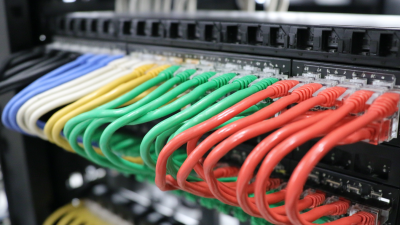The Future of Enterprise Networking Innovations Transforming Business Communication
 In the ever-evolving landscape of business communication, the future of enterprise networking stands at the forefront of transformational innovations.
According to a recent report by Gartner, the global enterprise networking market is projected to reach $50 billion by 2025, driven by the increasing demand for seamless connectivity and collaboration tools.
As businesses strive for greater efficiency and agility, innovations such as software-defined networking (SDN) and network function virtualization (NFV) are redefining how organizations communicate internally and externally.
These advancements not only enhance network performance but also support the growing trend of remote work and digital collaboration, which, as per a McKinsey survey, has accelerated digital transformation initiatives by 78% across various sectors.
Thus, understanding how these innovations will shape enterprise networking strategies is crucial for businesses aspiring to thrive in the digital age.
In the ever-evolving landscape of business communication, the future of enterprise networking stands at the forefront of transformational innovations.
According to a recent report by Gartner, the global enterprise networking market is projected to reach $50 billion by 2025, driven by the increasing demand for seamless connectivity and collaboration tools.
As businesses strive for greater efficiency and agility, innovations such as software-defined networking (SDN) and network function virtualization (NFV) are redefining how organizations communicate internally and externally.
These advancements not only enhance network performance but also support the growing trend of remote work and digital collaboration, which, as per a McKinsey survey, has accelerated digital transformation initiatives by 78% across various sectors.
Thus, understanding how these innovations will shape enterprise networking strategies is crucial for businesses aspiring to thrive in the digital age.
Innovative Technologies Shaping the Future of Enterprise Networks
Innovative technologies are revolutionizing enterprise networking, transforming how businesses communicate and operate. As organizations increasingly rely on cloud solutions, advancements in network virtualization are allowing for more flexible and scalable architectures. This shift not only enhances collaboration across various platforms but also enables real-time data access and sharing, fostering a more agile work environment. Technologies such as Software-Defined Networking (SDN) and Network Function Virtualization (NFV) are paving the way for smarter, more efficient networks that can adapt to changing business needs.
Moreover, the rise of AI and machine learning in enterprise networking is contributing to enhanced security and management capabilities. These technologies enable predictive analytics, allowing businesses to proactively address potential network issues before they escalate. With automated processes and improved threat detection, enterprises can maintain robust communications while safeguarding critical data. As these innovations continue to evolve, they promise to shape a more connected and resilient future for business communication, ensuring that organizations remain competitive in an ever-changing landscape.
Key Strategies for Implementing Effective Business Communication Solutions
Effective business communication is essential for enhancing collaboration and operational efficiency in today’s fast-paced enterprise environments. As organizations increasingly adopt unified communication solutions, they must focus on key strategies to implement these technologies successfully. One critical approach is to ensure that the chosen communication tools are seamlessly integrated into existing workflows. This integration minimizes disruption and fosters a smoother transition for employees accustomed to traditional platforms.

Tip: Invest in training sessions for employees to familiarize them with new systems. By providing thorough education on the tools being implemented, companies can enhance adoption rates and improve overall satisfaction among team members.
Another strategy is to prioritize user-friendly interfaces. Employees are more likely to embrace communication solutions that are intuitive and accessible. Selecting platforms that do not require extensive technical knowledge allows for greater participation across various departments, encouraging a culture of open communication.
Tip: Regularly gather feedback on the communication tools in use. This practice not only helps identify areas of improvement but also demonstrates to employees that their insights are valued, leading to a more engaged workforce.
Maximizing Collaboration through Next-Gen Networking Tools
The landscape of business communication is undergoing a dramatic transformation, fueled by the advent of next-gen networking tools designed to maximize collaboration. According to a report by Gartner, nearly 74% of organizations plan to increase their investments in collaborative technologies over the next two years. This trend is indicative of the growing recognition that effective communication platforms are essential for enhancing team productivity and driving innovation.

Enhancing Security Measures in Future Enterprise Networking
As businesses increasingly rely on digital communication frameworks, enhancing security measures in enterprise networking has become paramount. According to a report by Cybersecurity Ventures, global cybercrime damages are projected to reach $10.5 trillion annually by 2025, highlighting an urgent need for robust security strategies. Enterprises are adopting advanced encryption methods, multi-factor authentication, and artificial intelligence-driven threat detection to safeguard their communications against evolving cyber threats.
Moreover, the emergence of Software-Defined Wide Area Networking (SD-WAN) is revolutionizing data privacy and network security protocols. A study by Gartner indicates that by 2025, 60% of enterprises will move away from traditional WAN architectures in favor of SD-WAN, which provides greater visibility and control over data traffic. This shift not only enhances the security framework but also ensures that businesses can respond swiftly to potential security breaches, thereby maintaining the integrity of their communication systems and protecting sensitive information. Adopting these innovations is essential for businesses aiming to thrive in an increasingly connected and vulnerable digital landscape.
The Future of Enterprise Networking Innovations Transforming Business Communication - Enhancing Security Measures in Future Enterprise Networking
| Dimension | Description | Future Trends | Security Measures |
|---|---|---|---|
| SD-WAN | Software-Defined Wide Area Network technology for flexible connectivity. | Increased adoption in businesses for improved bandwidth usage. | Integrated security features like firewalls and encryption. |
| IoT Integration | Connecting devices securely to enhance operational efficiency. | Growing use in monitoring and automation systems. | Device authentication and anomaly detection capabilities. |
| Cloud Networking | Utilization of cloud services for network management. | Increased reliance on cloud service providers for scalability. | Advanced encryption protocols and multi-factor authentication. |
| AI and Automation | Using AI for network performance monitoring and management. | AI-driven insights for predictive maintenance and troubleshooting. | Automated security updates and threat response. |
| Data Privacy Regulations | Compliance with global data protection laws. | Increased focus on privacy-focused networking solutions. | Data encryption and privacy frameworks implementation. |
The Role of Artificial Intelligence in Transforming Business Communication
The integration of artificial intelligence (AI) into business communication is rapidly reshaping how enterprises operate and interact. As highlighted in recent reports, AI has the potential to enhance the value of global trade in goods and services by nearly 40% by 2040, fundamentally altering organizational strategies. With innovative AI-driven platforms enabling seamless communication and collaboration, businesses can now break down traditional barriers that have long inhibited productivity. For instance, predictive project management tools and intelligent communication systems are fostering enhanced knowledge sharing and driving better team collaboration.
Moreover, the shift towards an AI-centric approach is leading to the emergence of ultra-lean enterprises. By automating various operational tasks, companies can focus their resources on strategic innovation. This evolution is not just about efficiency; it represents a significant cultural shift in how businesses engage with technology and each other. As organizations embrace AI to facilitate better customer experiences and streamline collaboration, the workplace is transforming into a dynamic environment where human-AI partnerships unlock unprecedented potential, setting the stage for a new era in business communication.
The Role of Artificial Intelligence in Transforming Business Communication
Related Posts
-

Innovative Solutions for Optimizing Enterprise Networking Efficiency
-

10 Reasons Why Cat 6 Bulk Cable is Essential for Your Network Installation
-

The Essential Guide to Choosing the Right Network Cable for Your Home Office Setup
-

Seven Reasons Why Cat 6 Bulk Cable is the Best Choice for Your Networking Needs
-

Exploring Market Trends for Cat 6a Patch Panels at the 138th Canton Fair in 2025
-

Understanding the Impact of Cat 6A Cables on Network Performance and Future-Proofing Your Business
